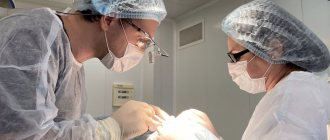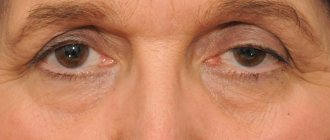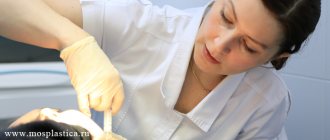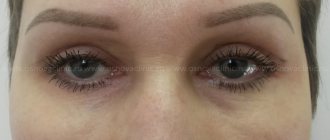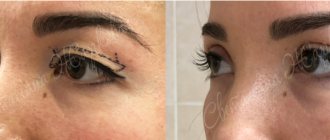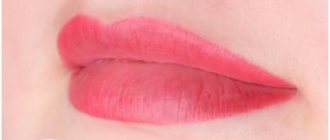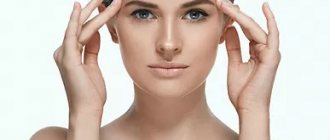Eyelid correction in plastic surgery occupies one of the leading positions in demand. The operation itself is quite simple, and modern techniques and a qualified surgeon are an almost complete guarantee of the absence of complications in the future. But a lot depends on the patient himself: one of the key stages is the rehabilitation period, where it is extremely important to strictly follow all the recommendations of your surgeon.
Rehabilitation after blepharoplasty of the upper and lower eyelids requires a number of restrictions, compliance with some simple rules and daily care of the operated area. Only with an integrated approach is it possible to speed up tissue healing as much as possible and guarantee an excellent aesthetic result. Patients' inattention to restorative measures sometimes causes quite serious complications.
How long does rehabilitation take after blepharoplasty?
The concept of “recovery period” includes everything from the operation itself to complete healing of the tissue. This is not only care or prohibitions, but also therapy, physiotherapy, therapeutic exercises and much more. Unfortunately, despite all the efforts of the doctor and the patient, at first, even with careful adherence to all prescriptions, various unpleasant sensations will cause discomfort:
- pain,
- dry mucous membranes,
- “sand” in the eyes, etc.
It is important to understand that discomfort, as well as some external effects (swelling, hematomas, etc.) are not beyond normal limits and are present after any operation.
Recovery time can take from two weeks to two months. Rehabilitation after blepharoplasty of the upper or lower eyelids is very individual and depends on the characteristics of the individual patient. For example, the age category of the patient is very influential - the older you are, the more difficult and longer the healing takes.
Stages of recovery after blepharoplasty by day:
- 1-2 days – swelling appears and increases within several hours after completion of the operation. The peak situation occurs at the end of the second day. Also, in some cases, hematomas may appear in the cheekbones and temporal area.
- Day 3-4 – swelling gradually decreases. Bruises change their color to yellowish-green.
- 5-7 days – swelling goes away.
- 8-10 days – slight swelling and traces of hematomas may remain. The patient is allowed to return to his usual rhythm of life.
- 20-60 days – you can observe the effect of the procedure. There is a possibility that a slight swelling will persist due to the excess fluid that is still in the tissues.
The speed of recovery after blepharoplasty largely depends on the person’s health. It may vary depending on the individual characteristics of the body.
Beautiful result of upper blepharoplasty in combination with lipofilling of the lower and upper eyelids. Photo from the website of D.R. Grishkyan. There are contraindications, specialist consultation is required
How long will the swelling and bruising last?
Bruising may appear even a couple of days after surgery. Swelling usually forms immediately after surgery. This is a natural process, there is nothing to fear here. Swelling usually goes away within 7-10 days after surgery. Bruises can last from two days to two weeks - this depends on the depth of the location, the thickness of the patient’s skin, the amount of bruising, the complexity of the operation, etc.
Blepharoplasty is an excellent method for correcting aesthetic or physiological imperfections.
Also affected, for example, is the location of the vascular network - the closer it is to the surface of the skin, the stronger and more intense the bruises will be and, accordingly, the longer they will subside. And after a couple of months, even scars become invisible, with the exception of paternal scars, which last a little longer.
Let's sum it up
What do you need to know about the postoperative period of blepharoplasty? Let's highlight the most important points: -The recovery period of blepharoplasty lasts no more than 2 weeks. Under normal conditions – 10 days; -If your profession does not involve increased eye strain, you can go to work already on the 7th day after surgery; – The results of blepharoplasty can ultimately be observed 10-14 days after surgery; -Ignoring recommendations, prohibitions and restrictions can prolong the recovery process; -UV rays, physical activity and eye strain are the main things to be afraid of in the first few days
If the article was useful, share it with your friends on social networks. Continue reading us to find out all the most interesting things from the world of beauty and health.
What else does the period depend on?
Recovery time also varies depending on the complexity and volume of operations and, of course, the technique. Rehabilitation after transconjunctival blepharoplasty will take less time than rehabilitation after circular blepharoplasty, because circular correction is more traumatic for tissues.
To speed up the resolution of bruises and swelling, you can apply cold compresses and use ointments that stimulate the reduction of bruising and swelling. It is also advisable to sleep in a semi-sitting position to prevent blood flow to the head. To do this you will need several pillows.
OPERATION.
Local anesthesia.
Incision.
Removal of hernias and excess skin.
A piece of skin from the upper eyelid.
Applying a suture.
Applying strips for fixation.
The operation is completed.
Rest in the ward after surgery.
About prohibitions
Any plastic surgery, including blepharoplasty, during the recovery period involves following a number of prohibitions established to preserve the patient’s health. For example, you should not bend over or do any actions that could lead to a rush of blood to your head. You are also not allowed to visit the sauna, bathhouse, swimming pool, beach or solarium. It is necessary to carefully protect the operated area from exposure to ultraviolet rays. Active sports and heavy physical activity are also excluded.
Rehabilitation after blepharoplasty surgery involves giving up bad habits - alcohol and smoking. In addition, it is strongly recommended to reduce fluid intake in the first days to prevent swelling from increasing.
It is important to remember that bans are a temporary measure, not a lifelong one. But violating these prohibitions can have the most unpleasant effect on the result of the operation.
How soon can I return home after surgery?
Typically, eyelid surgery is performed using local anesthesia or intravenous sedation, so the patient can go home the same day of surgery. If blepharoplasty was performed under general anesthesia, then the visit home is postponed until the next morning, since the patient needs to spend some time under the supervision of a doctor. What's next?
Scheme of medial canthoplaty
Transconjunctival blepharoplasty
Asian eyelid surgery Sangapuri
What drugs should I use?
During rehabilitation after laser or classical blepharoplasty, the doctor prescribes medications for external use that stimulate the resorption of bruises and the reduction of swelling. Some ointments or creams may be prescribed to relieve itching and speed up tissue regeneration. It is important to remember that you cannot prescribe medications for yourself, since the wrong prescription can ruin the result of the correction.
In addition to medications, physiotherapy may be indicated - microcurrents, darsonval and others. These treatments also stimulate faster tissue repair in the damaged area. But before you sign up for a particular procedure, you should definitely discuss it with your surgeon.
To speed up tissue healing, special ointments are used.
In rare cases, antibiotics and other antibacterial medications may be prescribed to minimize the risk of infection. Analgesics are also sometimes prescribed if the patient complains of acute pain.
Blepharoplasty of the lower eyelids - how is it done?
As already mentioned, transconjunctival lower blepharoplasty is performed without an incision in the skin and without a stitch. The traumatic nature of the operation is minimized; there are no postoperative scars or stitches. Seamless plastic surgery is designed to eliminate bags under the eyes and fatty hernias. In combination with laser skin resurfacing, this procedure effectively helps to get rid of age-related changes.
If in addition to bags under the eyes there are circles under the eyes, lower blepharoplasty with lipofilling. That is, by transplanting the patient’s own fat. And again, no cuts and no stitches. The seamless technique is characterized by rapid tissue healing and a completely natural result. The rehabilitation period is comfortable and fast.
Lower eyelid surgery - preparation
When lower blepharoplasty has already been planned and a date has been set, you will need to undergo a medical examination. You can have an electrocardiogram and tests that we prescribe for you at any clinic of your choice. Or in one of those where Dr. Fadin operates. The administration will help organize the process so that the examination will take no more than a couple of hours.
Two to three weeks before blepharoplasty, the patient should stop smoking. If you have eyelash extensions, please remove them. The fact is that after treating the eyes with an antiseptic solution, they may begin to fall off, and during the operation they will end up in the surgical wound. We, of course, carefully remove them, but this increases the operation time, and this is not good.
It is necessary to cure infectious diseases, if any. You should not take certain medications that affect your blood.
What else do you need to know about rehabilitation after blepharoplasty?
In the first days, it is undesirable to allow water, and especially detergents, to get into the intervention area. Personal hygiene is not prohibited, but it is advisable to wash your hair as in a hairdresser - with your head thrown back.
Of course, it is worth limiting the use of equipment such as a computer, smartphone, TV, etc. as much as possible.
In summer, it is necessary to use protective creams with a high SPF level, and also wear sunglasses. You will have to give up contact lenses, as well as makeup - cosmetics are allowed only some time after the operation, but only hypoallergenic ones or those marked “for sensitive skin.” It is better to discuss any care products with your surgeon in advance.
Compliance with recommendations, following the rules and prohibitions is an important stage in rehabilitation after blepharoplasty of the upper or lower eyelids. Only an integrated approach will allow you to get the look of your dreams.
Further rehabilitation
Rehabilitation after lower eyelid blepharoplasty will be completely completed in 40-60 days. By this time, the seams will become invisible and there will be no traces of intervention. And your new look will finally take shape.
But until this time, you must follow your doctor's recommendations. Such as:
- Avoid direct sunlight. Wear glasses with tinted lenses.
- Refrain from visiting solariums, baths, and swimming pools.
- Don't overuse phones and computers.
- Refrain from physical activity.
- Follow your diet. Avoid highly salted foods and fast food. Fatty, fried, smoked foods are not your option.
Dietary meats, vegetables, fruits, dairy products - these are the best things to eat during the rehabilitation period.
- Drink more water. But try to drink as little coffee as possible.
- Do not drink alcohol, do not smoke cigarettes.
- Monitor the condition of your eyes, use moisturizing drops if necessary.
- Do not overuse cosmetics. Continue to use hypoallergenic products for sensitive skin.
- Use only products approved by your surgeon.
- Do not take medications without consulting your doctor.
- Do not perform procedures such as massage, peeling, resurfacing without the permission of the plastic surgeon.
You can sign up for a consultation with me using this link. I will be happy to answer all your questions.
